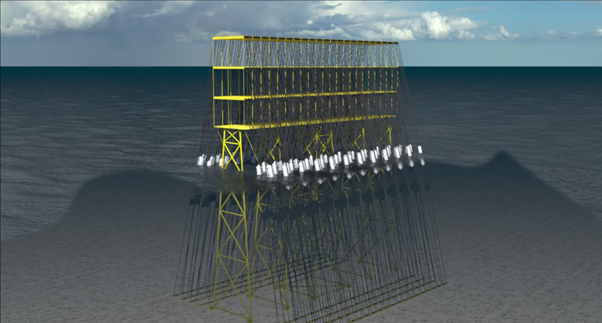We converge to a pseudo-optimal preliminary geometry and ballast management regime as a function of the wave climate and real time wave conditions at a selected site in the Norwegian coast.
The technology
The project envisioned technology, denoted the Hunting High series and developed/owned by , includes a set of floaters rigged in such a way that two types of wave energy harvesting are possible: one acting through the heave motion of a floater and another through the horizontal motion of the floater – each with an independent Power-Take-Off (PTO).
The design in question includes the possibility to completely submerge or emerge the floater as an intrinsic capability of the system, which may enhance considerably the survivability of the WEC.
A ballasting system is also in place, with the ability to modify the mass and mean draft of the floater, which may be used to tune the system parameters towards optimality as a function of the incoming wave system. Providing a robust active control system is in place, this may lead to significant enhancements of the WEC performance.
Methodology
The approach used is to base the results on (linear) hydrodynamic simulations in the frequency domain and compute the responses of the WEC in each mode to populate power matrices targeted at a reference deployment site, considering different designs and short-time ballast management regimes.
The procedure used for the simulations includes the modelling of generalized motion modes and analytically generated submerged surfaces to compute the forces at play. The computation of the hydrodynamic forces follows a potential flow assumption under a spline-based body boundary condition formulation. Furthermore, linearization procedures were applied through specifically designed fictitious-equivalent PTO’s to circumvent intrinsic nonlinearities in the WEC operation modes. Together, these methods allowed for a fast and robust multi-parameter screening to efficiently make an initial evaluation of possible design variations.
Design solutions
To arrive at a preliminary WEC floater configuration and short-term ballast management regime, a data frame is populated with results derived from nearly 1000 simulations with varying configurations, also considering an approximate-optimal PTO control approach. The most attractive configurations at this stage can then be chosen from the computed metrics, such as the estimate of the mean annual energy production and the estimated forces to which the system is subject to.

